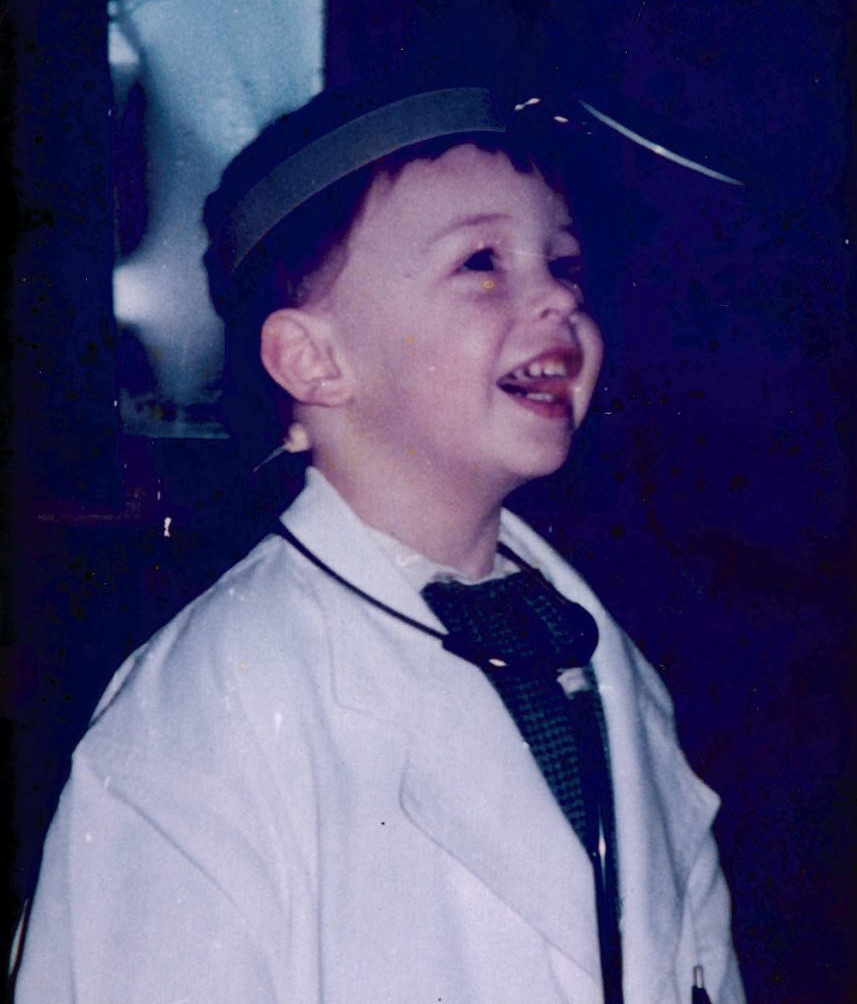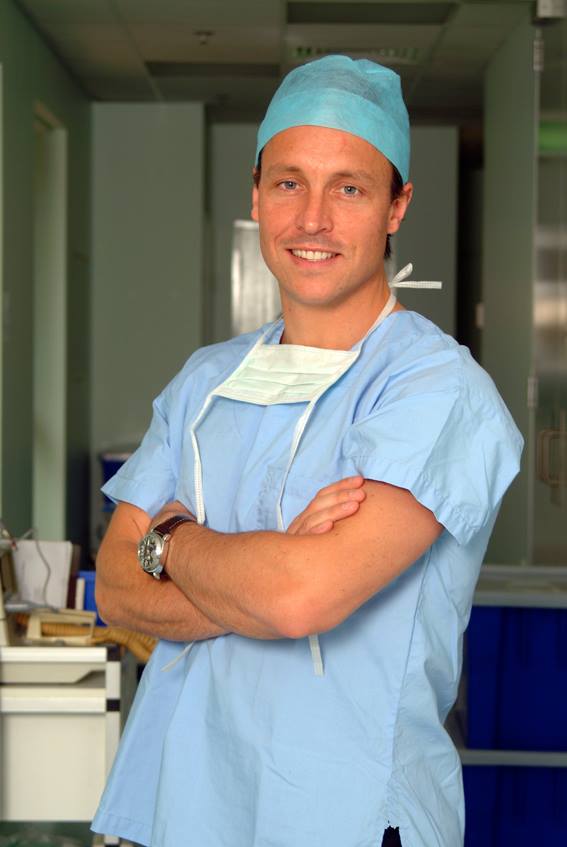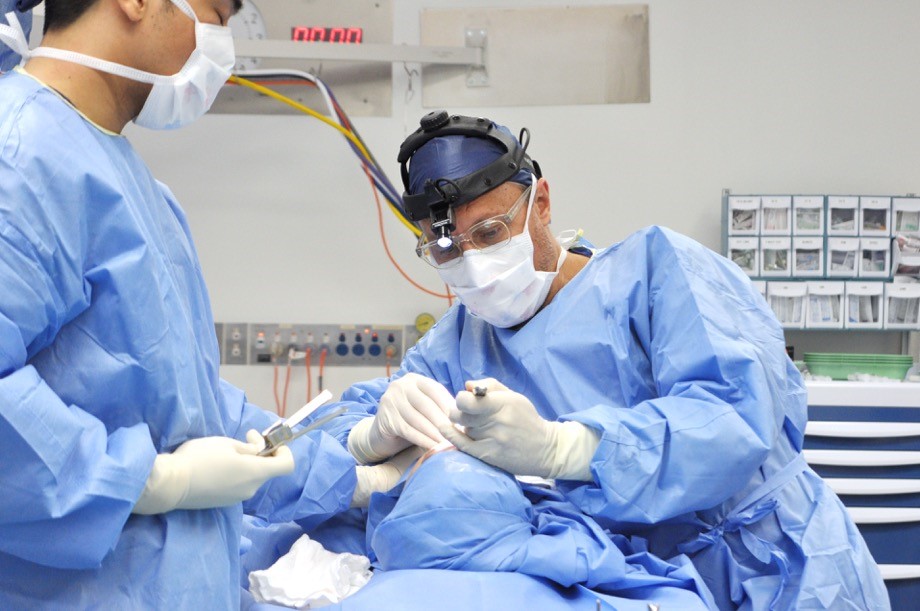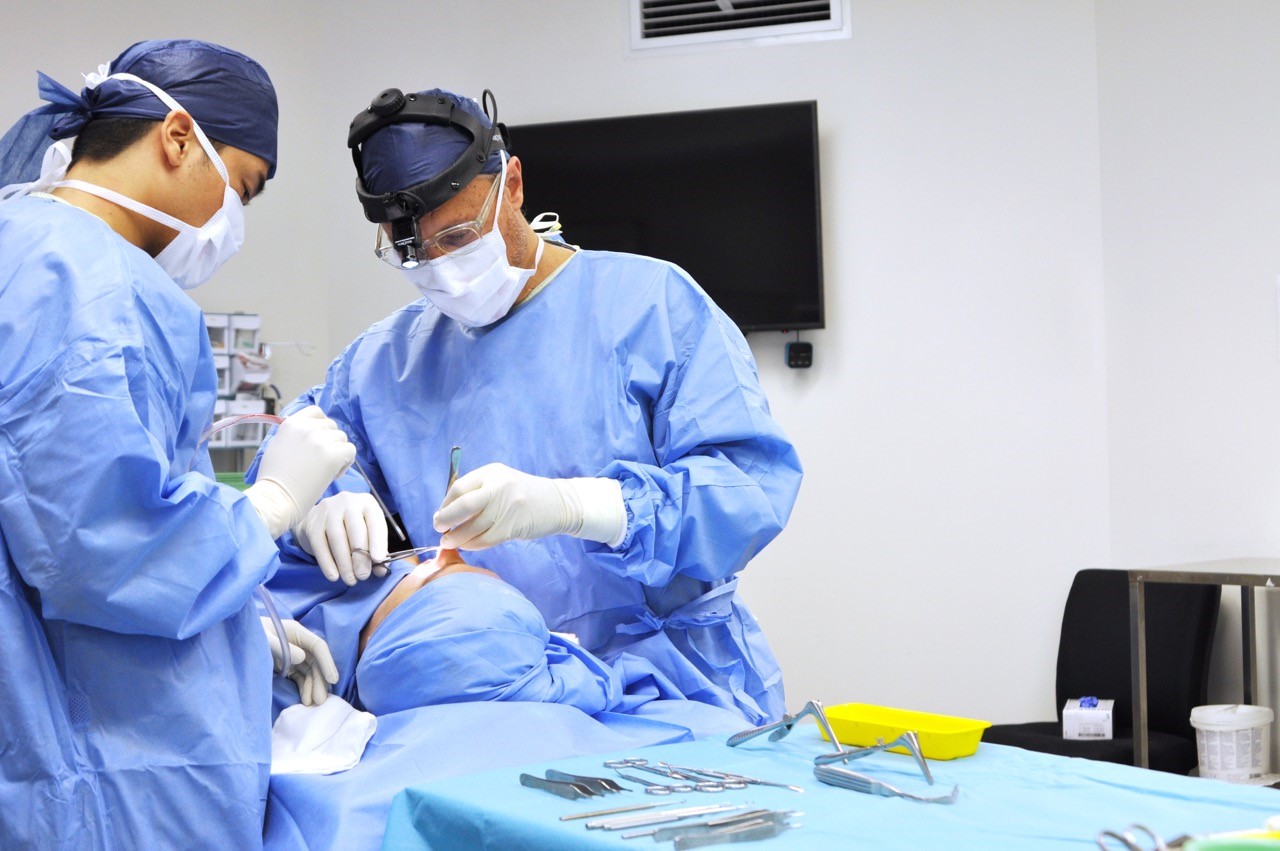
Dr William Mooney began his career at a most interesting time in medical history. Advances in technology were beginning to have an incredible impact on how we could operate upon and medically treat our patients. Dr Mooney began as a general surgeon but decided to specialise in Ear, Nose & Throat (ENT) surgery. From there he always had a plan to focus his career on head and neck cancer surgery and Rhinology.
After Dr Mooney set up practice he found himself seeing many nasal presentations and realised as well as improving breathing, the profound impact that the way people look and feel about themselves has on their personality and their potential for a happy life. At this point in time cosmetic nose surgery in Australia was still in it’s infancy.
Cosmetic surgery garners criticism from some quarters. Dr Mooney often says he feels those critics should walk in the shoes of some of his patients and see how treatment has improved their lives.
Whether Dr Mooney is correcting a sporting injury or addressing a person’s cosmetic concerns, it’s an enormous responsibility and challenge. He finds such a great joy being an ENT surgeon and working on reconstructing such important areas of a person’s face.
It takes decades to develop the skills required for this delicate work. One of his many mentors and teachers, Professor Bridger made an enormous impact on my life. The Prof’ used to say…
“In the first part of your career you learn how to operate, then you learn when to operate, then you learn when not to operate.”

I began my career at a most interesting time in medical history. Advances in technology were beginning to have an incredible impact on how we could operate upon and medically treat our patients. I began as a general surgeon but decided to specialise in Ear, Nose & Throat (ENT) surgery. From there I always had a plan to focus my career on head and neck cancer surgery and Rhinology.
After I set up practice I found myself seeing many nasal presentations and realised as well as improving breathing, the profound impact that the way people look and feel about themselves has on their personality and their potential for a happy life. At this point in time cosmetic nose surgery in Australia was still in it’s infancy.
Cosmetic surgery garners criticism from some quarters. I feel those critics should walk in the shoes of some of my patients and see how it has improved their lives.
Whether I am correcting a sporting injury or correcting a person’s feeling of self-worth, it’s an enormous responsibility and challenge. It is such a great joy to be an ENT surgeon and work on reconstructing such important areas of a person’s face.
It takes decades to develop the skills required for this delicate work. One of my many mentors and teachers, Professor Bridger made an enormous impact on my life, including with the saying:
“in the first part of your career you learn how to operate, then you learn when to operate, then you learn when not to operate.”
‘I’ve been interested in Medicine for as long as I can remember..’
DR WILLIAM MOONEY’S BACKGROUND
Dr Mooney says he was interested in medicine for as long as he can remember. He came from a medical background. His father was a wonderful, highly respected and accomplished paediatric ENT Surgeon. He was head of the ENT department at the Royal Children’s Hospital in Melbourne for 20 years. Dr Mooney senior was an innovator and introduced the first laser to ENT surgery in Australia in 1973. He used it to treat Laryngeal Papillomatosis, lesions in the voice box, that are potentially fatal for children. It’s a terrible complaint; one particular child required 112 operations– every time effectively saving this boy’s life! Dr Mooney calls his dad an inspiration, although the first time he took a young William into an operating theatre, aged 11, he fainted!
In his HSC Dr Mooney topped the state in Latin, which later would make anatomy, where so many names are in Latin, much easier.

I’ve been interested in Medicine for as long as I can remember
I come from a medical background. My father was a wonderful, highly respected and accoplished paediatric ENT Surgeon. he was head of the ENT department at the Royal Children’s Hospital in Melbourne for 20 years. He was an innovator and introduced the first laser to ENT surgery in Australia in 1973. He used it to treat Laryngeal Papillomatosis, lesions in the voice box, that can kill children. It’s a terrible complaint; one particular child required 112 operations– every time effectively saving this boy’s life! Dad was inspiring, although the first time he took me into an operating theatre, aged 11, I fainted!
In HSC I topped the state in Latin, which later would make anatomy, where so many names are in Latin, much easier.
Medical Training
MEDICAL TRAINING
Medical school took six years, with 40 hours of lectures each week. Dr Mooney chose Monash University because, at the time, he says he felt it was the more progressive of the two Melbourne Universities. He graduated in 1990 and won the Medical prize and the Surgical prize in his final year.
Then came his residency, a total of six years at the Alfred Hospital in Melbourne. Although Dr Mooney tried many specialities, he kept being drawn back to ENT. William remembers being simply fascinated with the depth and breadth of the specialty. It covered areas such as Neurosurgery, paediatrics, laryngology, head and neck cancer oncology as well as of course Rhinoplasty and Facial Plastic Surgery.
The only other speciality Dr Mooney was interested in was plastic surgery. However, it was a very different era to now, as the only plastic surgery he saw in the public hospitals was amputations, burn victims and other traumas. About the only elective cosmetic surgery was Otoplasty(ear), Rhinoplasty(nose) and Breast Augmentation, and in those days, was not commonly performed, nor was it taught in detail.
When Dr William Mooney decided to officially specialise in ENT Surgery, he joined the four-year intensive training program in NSW. His first placement was at John Hunter Teaching Hospital in Newcastle. This was an incredible hospital with an enormous throughput of surgeries, allowing him to really hone his skills on a variety of procedures from Paediatrics to incredibly delicate layngeal (voice box) operations. In my training Dr Mooney worked at some of the leading hospitals in the country including Prince of Wales and Prince Alfred. At the end of these four years, he qualified as an ENT surgeon, but prior to setting up private practice Dr Mooney made the decision to focus his future work on Rhinology and Head and Neck Cancer.

Medical Training
DR WILLIAM MOONEY’S MEDICAL TRAINING
Medical school took six years, with 40 hours of lectures each week. I chose Monash University because, at the time, I felt it was the more progressive of the two Melbourne Universities. I graduated in 1990 and won the Medical prize and the Surgical prize in my final year.
Then came hospital residency, a total of six years at the Alfred Hospital in Melbourne. Although I tried many specialities, he kept being drawn back to ENT. I remember being simply fascinated with the depth and breadth of the specialty. It covered areas such as Neurosurgery, paediatrics, laryngology, head and neck cancer oncology as well as of course Rhinoplasty and Facial Plastic Surgery.
The only other speciality I was interested in was plastic surgery. However, it was a very different era to now, as the only plastic surgery I saw in the public hospitals was amputations, burns victims and other traumas. About the only elective cosmetic surgery was Otoplasty(ear), Rhinoplasty(nose) and Breast Augmentation, and in those days, was not commonly performed, nor was it taught in detail.
When I decided to officially specialise in ENT Surgery, I joined the four-year intensive training program in NSW. My first placement was at John Hunter Teaching Hospital in Newcastle. This was an incredible hospital with an enormous throughput of surgeries, allowing me to really hone my skills on a variety of procedures from Paediatrics to incredibly delicate layngeal (voice box) operations. In my training I worked at some of the leading hospitals in the country including Prince of Wales and Prince Alfred. At the end of these four years, I qualified as an ENT surgeon, but prior to setting up private practice I made the decision to focus my future work on Rhinology and Head and Neck Cancer.
”I love my work. Rhinoplasty, whether to fix a sporting injury, or the way a person feels about his/her looks, is the most intricate cosmetic procedure as it combines the treatment of both function and form, a delicate balance between medical science and artistry.
Dr William MooneyMBBS FRACS MAAFPS
Fellowships
SHADOWING LEADERS IN THE FIELD
SHADOWING LEADERS IN THE FIELD.
After being awarded his fellowship, Dr Mooney spent six months at the Australasian Academy of Facial Plastic Surgery in Sydney. This was critical to learn how to run a practice as most ENT surgeons have a combined private practice and public hospital appointments.
Then to London to work under two specialists famed in their fields.
David Howard (Past President of the British Laryngological Association), is one of the most renowned head and neck cancer surgeons, anywhere. Howard was very calm, steady and deliberate. Dr Mooney says Howard taught him an invaluable technique to ensure each operative step progressed the surgery forward in order to advance the operation. This was critical learning. William often says it taught him to operate calmly, effectively and always with purpose.
Professor Valerie Lund is Professor of Rhinology at the Ear Institute, University College London and is an Honorary Consultant ENT Surgeon at the Royal National Throat Nose and Ear Hospital (University College London Trust), Moorfields Eye Hospital, and University College Hospital. She is considered one of the greatest rhinologists in the world. She taught Dr Mooney a delicacy in assessing and treating the nose and the value of a more restrained approach – the balance of surgery and medicine. She probably operated on about one in eight of her rhinology patients, treating many of the others with medications and a conservative technique.

Fellowships
Shadowing leaders in the field
Six months at the Australasian Academy of Facial Plastic Surgery in Sydney was critical to learn how to run a practice as most ENT surgeons go into private practice with a mix of public hospital appointments.
Then to London to work under two specialists famed in their fields.
David Howard (President of British Laryngological Association), is one of the best head and neck cancer surgeons, anywhere. Howard was very calm, steady and deliberate. He taught me an invaluable technique to ensure each operative step progressed the surgery forward in order to advance the operation. This was critical learning. It taught me to operate calmly, effectively and always with purpose.
Professor Valerie Lund is Professor of Rhinology at the Ear Institute, University College London and is an Honorary Consultant ENT Surgeon at the Royal National Throat Nose and Ear Hospital (University College London Trust), Moorfields Eye Hospital, and University College Hospital. She is considered one of the greatest rhinologists in the world. She taught me the delicacy of the nose and the value of a more restrained approach – the balance of surgery and medicine. She probably operated on about one in eight of her rhinology patients, treating many of the others with medications and a conservative technique.
.
In Paris Dr William Mooney worked with Jean Abitol who at the time was the voice guru. He introduced him to the intricacies of the larynx (voice box) and the micro instruments required. He also taught Dr Mooney the importance of the connection between psychology and laryngology: the important interplay between the voice and the mental health of his patients. Over time, Dr Mooney believes he has extrapolated this learning to emphasise the importance of mind and body on all his patients. We now live in a time where we commonly see body dysmorphia, which is the anxiety around one’s appearance. This was his first insight into how important the stability of the mind is to the health of my patients.
In New York Dr Mooney spent time with Jatin P. Shah, considered the ‘Godfather’ of head and neck cancer surgery, at the Memorial Sloan Kettering Cancer Centre, the leading cancer centre in the world.
Then to the Lasky Clinic in Beverly Hills, which is focused on Rhinology and cosmetic facial surgery for the stars. Dr Mooney says he found LA was a different world! Up until this time was a rhinoplasty surgical technique called the Goldman Tip (reconstruction of the nose tip), which is fast and looks good, but long term has problems. William always says it was an important lesson in what not to do. Dr Mooney still fixes a lot of Goldman Tip’s to this day. Also, many of his patients were African Americans who wanted to reduce the width of their nostrils. Interestingly Dr Mooney wasn’t happy with the techniques being used as dark skin often scars signficantly, so he developed an internal scarless alar base reduction technique, which he uses to this day.

In Paris I worked with Jean Abitol who at the time was the voice guru. He introduced me to the intricacies of the voice box and the micro instruments required. He also taught me the importance of the connection between psychology and laryngology: the important interplay between the voice and the mental health of his patients. Over time, I have extrapolated this learning to emphasise the importance of mind and body on all our patients. We now live in a time where we commonly see body dysmorphia, which is the anxiety around one’s appearance. This was my first insight into how important the stability of the mind is to the health of my patients.
In New York I spent time with Jatin P. Shah, known as the godfather of head and neck cancer surgery, at the Memorial Sloan Kettering Cancer Centre, the leading cancer centre in the world.
Then to the Lasky Clinic in Beverly Hills, which is focused on Rhinology and cosmetic facial surgery for the stars. LA was a different world! Up until this time was a rhinoplasty surgical technique called the Goldman Tip (reconstruction of the nose tip), which is fast and looks good, but long term has problems. It was an important lesson in what not to do. I still fix a lot of Goldman Tip’s to this day. Also, many of my patients were African Americans who wanted to reduce the width of their nostrils. I wasn’t happy with the techniques being used as dark skin scars easily, so developed an internal scarless alar base reduction technique, which we use to this day.
Moving home
Back in Australia
DR MOONEY RETURNS TO AUSTRALIA
Initially I worked in Melbourne with Dad. Then in 2003 I was invited to join the practice of one of my surgical mentors, Professor Bridger, a head and neck cancer surgeon. It was a fortuitous decision because of the cultural diversity in western Sydney, I learnt a huge skill set. I was exposed to nose patients of both sexes, with a great deal of trauma, sporting violence, reduction rhinoplasty, augmentation rhinoplasty, alar based reduction, and more. Five years later I extended my practice to Bondi Junction. I now have 33 years of diverse experience as a practising doctor and 22 years as an ENT Surgeon.
I honestly love my work. Rhinoplasty, whether to fix a sporting injury, or the way a person feels about their looks, is the most intricate cosmetic procedure as it combines the treatment of both function and form, a delicate balance between medical science and artistry.
I plan to continue operating and performing surgery on my two main passions; Rhinology and Head and Neck Cancer Surgery.
Also very important to me is my philanthropic work, cancer and general work in the public sector, and my involvement in indigenous health and an outreach program with clinic visits to rural communities in NSW.
I am an active member of the NICENT (Aboriginal Torres Strait Island ENT society), attend their meetings, am involved in research and attend remote clinics frequenty.
Research is important to me and as well as presentations for NICENT-ENT I am working on projects in Sydney. We are refining a Plasma-cartilage graft for rhinoplasty. I am also interested in the relationship between nasal obstruction and mental health which I am finding is a very real thing.
My chosen profession is both challenging and extremely rewarding. Rhinoplasty, in particular, is constantly evolving to produce better outcome, making it efficacious and beneficial to my patients.
This is an exciting medial sector where one never stops learning and growing. In April, 2018 while lecturing at the Rhinology conference in Perth (hosted by the Australian Academy of Facial Plastic Surgery) I was humbled by the array of talent and forward thinking by my peers. Australia really is at the forefront of best practice in the field of Rhinoplasty. It’s an honour to be operating among the top echelons of surgeons.
I plan to continue operating and performing surgery on my two main passions; Rhinology and Head and Neck Cancer Surgery.
Also very important to me is his philanthropic work, cancer and general work in the public sector, and my involvement in indigenous health and an outreach program with clinic visits to rural communities in NSW.
Research has always been important to me, and as well as presentations for NICENT I am working on projects in Sydney. In the last two years I have set up a stem-cell research project, which I believe is the new ‘frontier’ in modern medicine. I am also refining a Plasma-cartilage graft for rhinoplasty. I am also interested in the relationship between nasal obstruction and mental health which I feel is a very real thing.
I often describe my chosen profession as both challenging and extremely rewarding. Rhinoplasty, in particular, is constantly evolving to produce better outcome, making it efficacious and beneficial to his patients.
This is an exciting medical sector where one never stops learning and growing. In April, 2018 while lecturing at the Rhinology conference in Perth (hosted by the Australian Academy of Facial Plastic Surgery) I was humbled by the array of talent and forward thinking by my peers. Australia really is at the forefront of best practice in the field of Rhinoplasty. I believe it is an honour to be operating among the top echelons of surgeons.
In 2016 through my Bankstown clinic (and in association with Bankstown Police and social services) I set up a pro-bono domestic violence facial trauma clinic. Often these victims had suffered trauma, fractured noses, facial scarring that couldn’t be treated in the Public Hospital system. At the same time their scars served as a constant reminder of the often horrific trauma they had suffered. The clinic was designed to help people who had in effect fallen through the cracks of the health care system. I look forwards to continuing this work in my new clinics.
A huge advancement for the cosmetic industry is more thoroughly assessing the overall health of the patient, especially mental health prior to surgery. We now place a huge importance on lifestyle, naturopathy and the human psyche. Accommodating these holistic factors represents new thinking for traditional medicine and I am convinced they yield better long-term results for our patients.
I believe we are living in an era of extraordinary scientific advancements. We now use better materials, better medicines and better anaesthetic techniques. These medical improvements help us care for our patients and achieve better results long term.
We are also moving away from conventional surgical techniques and developing less invasive, in clinic, injectable options. The younger generations are dictating this demand for better product, for less, with immediate results. While these cost-effective alternatives won’t always replace surgery, they fill a critical gap in the cosmetic market.
As a father of two children, I am often nostalgic about my own upbringing and the incredible impact my father’s career had on my own career choices. I always impresse upon my kids the things dad believed: to be honest, meticulous and perform any task to the best of one’s ability. Whatever careers they choose, if they carry these motifs, he believes they will lead successful and honourable lives.
INDIGENOUS OUTREACH
Dr Mooney first attended regional indigenous communities as a surgical trainee flying to remote communities like Brewarrina in far Western New South Wales. During this time, he also attended a weekly indigenous outpatient clinic in Redfern. After his Fellowship, Dr Mooney travelled to the Northern Territory 50 times in 15 years.
He established a clinic in Darwin which had significant Indigenous patients throughput. He also travelled to Tennent Creek and Katherine during this time.
Dr Mooney has been involved in the NICENT (National Indigenous Coordination of ENT surgeons) committee which involves frequent meetings, research and visits to regional communities and clinics. He regularly visits clinics in Forster and Taree, as well as Tamworth and Inverell.

INDIGENOUS OUTREACH
I first attended regional indigenous communities as a surgical trainee flying to remote communities like Brewarrina in far Western New South Wales. During this time, I also attended a weekly indigenous outpatient clinic in Redfern. After his Fellowship, I travelled to the Northern Territory 50 times in 15 years.
I established a clinic in Darwin which had significant Indigenous patients throughput. I also travelled to Tennent Creek and Katherine during this time.
I have been involved in the NICENT (National Indigenous Coordination of ENT surgeons) committee which involves frequent meetings, research and visits to regional communities and clinics. I have regularly visited clinics in Forster and Taree, as well as Tamworth and Inverell.
Ear disease is a significant issue for indigenous children as it further disadvantages them in many aspects of their life. Deafness associated with recurrent infections can make school a challenge. Early active treatment of ear disease can make a massive difference in the lives of these patients.
Dr Mooney is passionate about helping these communities and plans to remain active in the service of these Australians.

Ear disease is a significant issue for indigenous children as it further disadvantages them in many aspects of their life. Deafness associated with recurrent infections can make school a challenge. Early active treatment of ear disease can make a massive difference in the lives of these patients.
I am passionate about helping these communities and plans to remain active in the service of these Australians.
